Introduction: Annapurna Base Camp Short Trekking 2025/2026
Annapurna Base Camp Short Trekking is a perfect way to be close to the Himalayan Mountains in less than the duration of time within a week, an ideal walk for travelers with limited time in Nepal but with dreams to reach the base of the world's highest mountains.
Short Annapurna Base Camp Trek takes you to its scenic country, walking from lo,w warm farm areas to reach cooler alpine hills with constant views of high Annapurna Peaks in the harmony of local villages enriched with timeless culture and age-old customs of great interest.
The walk leads into a beautiful country enclosed by a lovely green forest of tall rhododendron and pine trees, with an overnight stop in a local village lodge with the opportunity to soak in local traditional farm life.
The journey continues into the deep gorge of the Modi River to reach a vast open plateau at Annapurna Sanctuary encircled by a series of high peaks of the Annapurna Himalaya range.
On reaching the scenic sanctuary where a short walk leads you right to the heart of Annapurna Base Camp, the only base in the whole Himalayas with facilities of a nice and cozy lodge right beneath towering giant mountains.
Enjoying time overlooking dramatic views of mighty peaks and then back to Chomrong on the same trail, and then taking an alternative route with a visit to Jhinu village to refresh in its hot natural spring before heading back to Pokhara after a great adventure and experience on Annapurna Short Trekking.
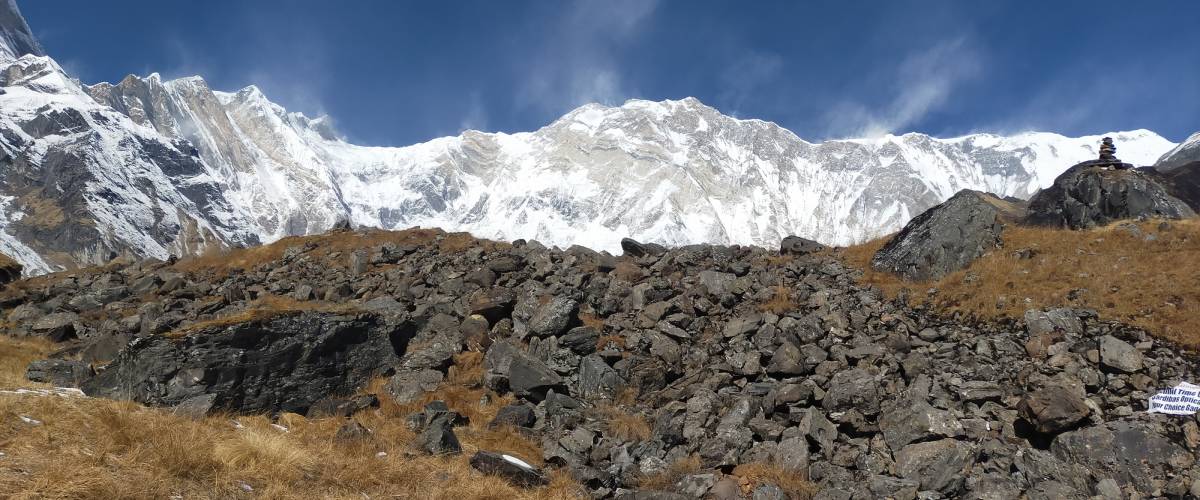
Best season to do Annapurna Base Camp Short Trekking
Please be informed that Annapurna Base Camp Short Trekking will be best in the spring season of March to May when days are longer with much sunlight hours from early 6 a.m. till late 6 p.m. which helps to cover much distance each day to designated overnight stops.
As well around this time when wildflowers are in season with colorful hills with flowers in bloom, especially the Rhododendron (National flower of Nepal) which you will find from tall trees to high bushes and with Rhododendron plants known as Azalea.
Why Annapurna Base Camp Short Trek?
ABC is one of most popular and spectacular trek in Nepal, giving stunning vistas of the Annapurna Range as well as various landscapes.
Annapurna Base Camp Short Trek itinerary is a popular choice for those with limited time but still want to see the Annapurna Region's beauty. Here are a few reasons why an 8 Days walk would be an ideal idea:
- Well Defined Trail: The Annapurna Base Camp Trek follows a well-defined trail that is generally straightforward to follow. The track is well-marked and provides clear directions, making it ideal for people to explore the trial.
- Affordable: The Annapurna Base Camp climb is widely regarded as the affordable treks in Nepal. The cost of the trek varies according to the level of service and accommodations chosen, but an 8 Days route is often less expensive than lengthier treks. Besides Trekking Planner Nepal provides itinerary as per your budget and requirement.
- Moderate Altitude: The Annapurna Base Camp trek's highest point is 4,130 meters (13,550 ft.) at Annapurna Base Camp. The trek does not include any high passes and also there is less chances of altitude sickness.
- Beautiful Views: The Annapurna Base Camp trek is famous for the stunning panorama of the Annapurna Range, including some of the highest peaks in the world. The route takes you through beautiful woodlands, terraced farms, and medieval villages, offering a variety of vistas and sights.
- Cultural Experience: The trek passes through several traditional Gurung and Magar villages, providing a unique opportunity to learn about local culture and lifestyle. You have the opportunity to connect with locals and learn about their customs, traditions, and daily lives.
- Hot Springs: The trek includes a visit to natural hot springs located in Jhinu Danda, where you can relax and heal their aching muscles after a long day of hiking. The hot spring is famous spot to relax and spend some time in the natural spring.
- Wildlife Spotting: The Annapurna Region is home to a diverse range of species, including snow leopards, Himalayan black bears, and langurs. You may encounter some of these animals along the trip.
An itinerary provides a well-rounded trekking experience that combines natural beauty, cultural richness, and affordable adventure. The Annapurna Base Camp hike is a must-do for anyone visiting Nepal, whether they are novice or experienced trekkers.

Is 8 Days Annapurna Base Camp Trekking Right for you?
Your trekking experience, physical level, and personal preferences will determine whether an Annapurna Base Camp Trekking plan is ideal for you. Here are some things Trekking Planner Nepal suggest you to think about before embarking on trek:
- Trekking Experience: The Annapurna Base Camp trek is classified as comparatively moderate, requiring an average level of fitness and prior trekking experience. An 8-day itinerary, on the other hand, is appropriate also for most beginners who have some experience with multi-day treks.
- Fitness Level: The Annapurna Base Camp journey requires several hours of walking each day and includes some steep uphill and downhill stretches. You should be in good physical shape and be able to walk for 5-7 hours per day.
- Altitude Sickness: The highest point on the climb to Annapurna Base Camp is 4,130 meters (13,550 ft). Though the chances of getting altitude are less in the Annapurna Region comparatively, you still need to take this topic seriously. Altitude could catch anyone at an elevated place. So, it is better if you consult with your doctor before heading on the trek.
- Budget: The Annapurna Base Camp trek is widely regarded as one of affordable treks in Nepal. Hoewever, the cost of the expedition, might vary depending on the level of service and lodgings chosen.
- Time: An 8 Days schedule allows you to explore the Annapurna Region's magnificence while remaining reasonable in terms of time and effort. If you only have 8 Days.
Overall, an Annapurna Base Camp Trek schedule can be a wonderful choice if you have prior trekking experience, an appropriate level of fitness, and are comfortable walking for several hours every day. The walk provides beautiful views of the Annapurna range, an opportunity to explore local culture, and is usually regarded as one of economical treks of Nepal. If you want a more adventerous and challenging trail, then you can try the north Annapurna base camp trek as well.
How should you prepare for Annapurna Base Camp trek?
For the preparation for an 8 Days journey to Annapurna Base Camp needs both physical and mental preparation. Here are some suggestions that might help you for the preparation on your adventure:
- Physical Fitness: The Annapurna Base Camp treks requires several hours of trekking each day on difficult uphill and downhill trails. As a result, it is of the utmost importance to maintain your physical fitness level by regular exercise, which includes cardio, strength, and endurance training. This will build up your level of strength and helps you walking 5-6 hours per day.
- Walking Practice: Walking practice is essential for getting used to walking long distances in mountainous terrain. You must begin by walking modest distances on difficult terrain and progressively increase the distance and elevation.
- Proper Equipment: Proper equipment is essential for a comfortable and safe hiking experience. Invest on durable hiking boots, weather-appropriate clothing, a warm jacket, a raincoat, a high-quality backpack, and other important trekking equipment.
- Preventing Altitude Sickness: The Annapurna Base Camp hike entails ascending to a relatively high altitude, and altitude sickness can arise as a result of sudden changes in elevation. It is essential to fully acclimate by taking appropriate rest and drinking breaks, as well as maybe taking altitude sickness medicine if required.
- Mental Preparation: Mountain trekking is an adventure that may be both physically and mentally demanding. It is important to psychologically prepare yourself for any obstacles that may arise during the walk.
- Consult your Doctor: Before embarking on a trekking adventure, consult your doctor to ensure that you are physically fit enough to handle the physical demands of mountain trekking.
You can have a comfortable and joyful trekking adventure to Annapurna Base Camp if you follow these suggestions and carefully prepare yourself.
Climate and Weather around annapurna
The climate and weather of Annapurna Base Camp can vary depending on the season you choose to hike. Here is an outline of the weather conditions you may expect during each season:
- Spring (March to May): This is the busiest trekking season, with mild and pleasant weather. During the day, temperatures range from 10°C to 20°C, and at night, temperatures range from 0°C to 5°C. The skies are normally clear, with maybe a few showers on the way there.
- Summer/Monsoon (June to August): The weather is hot and humid, with regular showers. The daytime temperature ranges from 15°C to 25°C, while the nighttime temperature ranges from 5°C to 10°C. Rain can make the trails slick and muddy, and there may be landslides or floods on occasion.
- Autumn (September to November): This is another high trekking season, with cool and dry weather. During the day, the temperature fluctuates from 10°C to 20°C, while at night, it drops to roughly -5°C to 5°C. The sky are frequently clear, allowing for breathtaking vistas of the mountains.
- Winter (December to February): This is the coldest season, with dry and chilly weather. During the day, the temperature ranges from 5°C to 15°C, while at night, it drops to roughly -10°C to -5°C. The skies are normally clear, but higher elevations may get snowfall on occasion.
It is important to pack clothing and equipment appropriate for the weather conditions you can expect throughout the trip. Trekking throughout the spring and autumn seasons is often advised for the best weather and mountain vistas.

Local Culture and Tradition along the trekking trail
Several indigenous communities with distinct cultures and traditions live in the Annapurna Region. Here are some of the local cultures and traditions you can experience during your trek to the base camp of Annapurna.
Aside from the Gurungs, the Annapurna Region is home to other ethnic groups such as the Magars, Thakalis, and Manangis, each with their own culture and traditions. The Magars are famed for their warrior-like characteristics, and their martial arts and archery talents can be seen during festivals such as the Ghode Jatra. The Thakalis are well-known for their business acumen and are well-known dealers and hotels in the region. The Manangis, on the other hand, are Tibetan Buddhists with their own traditions, language, and rituals.
Interacting with the people is an important component of the Annapurna Base Camp Trek. You may explore their villages and learn about their customs and traditions, as well as sample their local cuisine and attend festivals and cultural events. It is critical to respect the customs and traditions of the local people and to interact with them in a friendly and respectful manner.
Is Travel Insurance required for Annapurna Base Camp
Trekking Planner Nepal is strongly advised though its not mandatory for anyone wanting to trek to Annapurna Base Camp. It is essential to select an insurance policy that covers high-altitude trekking, medical crises, emergency evacuation, and repatriation.
When choosing a travel insurance policy, it is essential to carefully read the fine print and ensure that the insurance you are getting covers all potential risks and hazards associated with trekking. Some insurance policies may exclude coverage for activities such as high-altitude trekking, leaving you without coverage if you have any problems during your trek.
It is also important to check that your insurance policy covers emergency medical bills and evacuation in the event of a medical emergency. Medical facilities in the Annapurna Region are limited, and in the event of a serious medical emergency, helicopter evacuation may be required, which might be costly.
You should also ensure that the insurance policy covers travel cancellation, trip interruption, and lost or stolen luggage. These are common problems that might arise when traveling, and having coverage can assist you in recovering the costs associated with them.
Overall, it is vital to purchase a comprehensive travel insurance policy that covers all potential risks and hazards associated with trekking in the Annapurna region. Before purchasing insurance, it is best to buy from a reputable insurance provider and carefully read the policy details.
Altitude Sickness
The height of a location above sea level is referred to as its altitude. As altitude increases, air pressure and oxygen levels decrease, making breathing more difficult and putting more strain on the body. Altitude sickness, commonly known as Acute Mountain Sickness (AMS), is a concern for anyone walking at high altitudes, particularly those trekking to Annapurna Base Camp.
When the body is not acclimatized to the drop in oxygen levels at high altitudes, altitude sickness occurs. Headaches, nausea, vomiting, dizziness, exhaustion, and difficulty sleeping are all symptoms of altitude sickness. Altitude sickness can induce fluid buildup in the lungs and brain, which can be fatal in severe cases.
To avoid altitude sickness, it is important to properly acclimate by gradually ascending to higher altitudes over a period of several days. Acclimatization should be taken before reaching Annapurna Base Camp. It is best to stay hydrated, consume high-carbohydrate foods, and avoid alcohol and smoking during acclimatization.
If you develop altitude sickness symptoms, it is important to rest, stay hydrated, and prevent additional ascent until the symptoms pass. If the symptoms increase, you may need to lower your altitude or seek medical treatment.
Proper planning and knowledge of altitude sickness can assist in ensuring a safe and pleasurable hike to Annapurna Base Camp. It is critical to take the essential precautions, such as acclimatization, hydration, and detecting altitude sickness symptoms. Trekking Planner Nepal helps you with the proper itinerary including enough days for acclimatization. Also, we provide you well-trained guide who takes you up in the mountains as per your health and mental state.
Washing, Toilet and Accommodation
Toilets and washing facilities on the Annapurna Base Camp trip differ based on the kind of lodging. Most tea shops along the walking route provide modest washing facilities, such as a bucket of hot water for bathing and a shared toilet. It is recommended that you bring your own necessities, including toilet paper, soap, and a towel, as up in the mountains you may lack all the items.
Tea houses, which are small lodges that give minimal amenities like as a bed, blankets, and pillows, provide lodging on the walk. Some tea houses also have a dining area where meals are served. Accommodation in the tea houses is on a twin-sharing basis, and single rooms may not be available at all tea houses.
The tea houses are simple, and you should adjust your expectations accordingly. The rooms are frequently small and simple, and the restrooms are normally squats. The tea rooms, on the other hand, provide a warm and welcome ambiance, and the tea house owners are frequently quite hospitable and friendly.
It is important to note that housing and facilities may be limited during peak trekking season, so it is best to plan ahead of time. Also, in some tea houses, electricity and hot water may not be available at all times, so bring a portable charger and a flashlight.
While the accommodation and washing facilities on the Annapurna Base Camp trek are basic, they offer a unique opportunity to experience the local culture and hospitality of the tea house owners, which is an essential part of the trekking experience.
During the peak season, the hotel rooms get crowded so Trekking Planner Nepal books your rooms in advance after you conformed booking so you don’t have to worry about the trip.
Important Note
- This trip departs every day of the year.
- This trip is fully customizable. We can customize the trip as per your need, please get in touch with us.
- This trip is available on both Fixed Departure and Private Group Basis.
- This trip can be booked privately if you’re traveling solo or privately or with family.
- Have a big group? We can help as per your needs.
- We can help you make it fit your budget.
- We accept an instant booking and online payment.


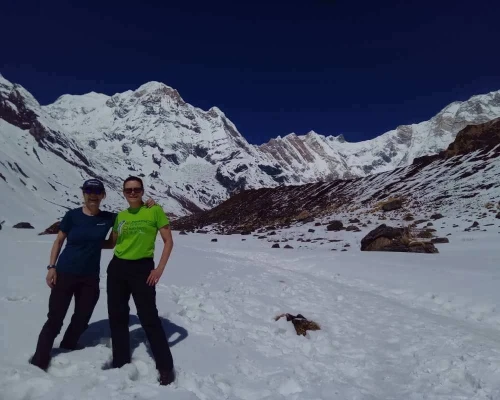
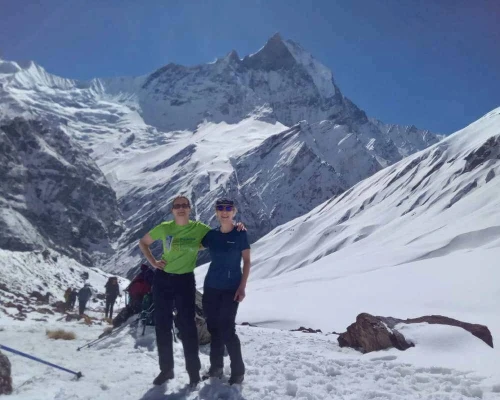

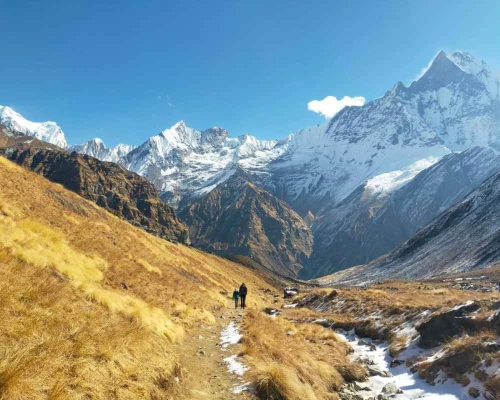
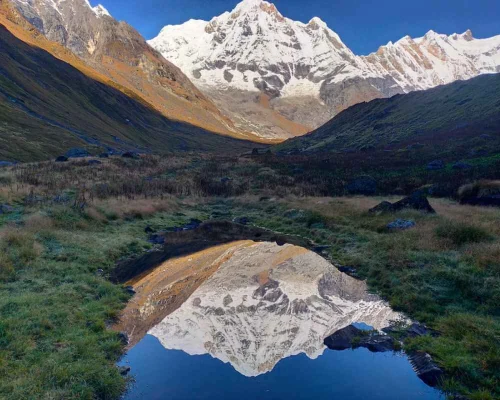
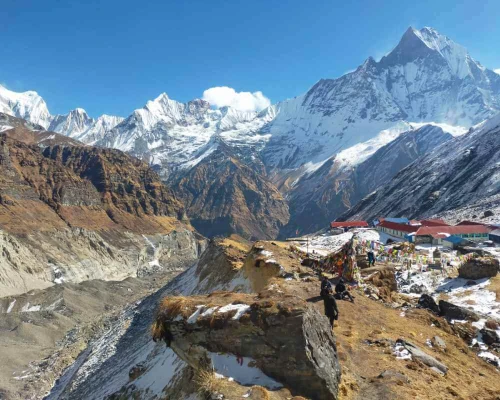



 General
General Upper Body
Upper Body Lower Body
Lower Body Other Essentials
Other Essentials


